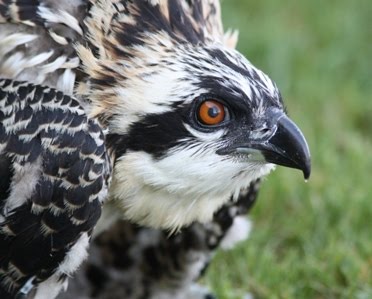Please report new Osprey nests to Vanessa Greene at Osprey.mn@gmail.com Volunteer to monitor a nest!

Sunday, March 30, 2014
2013 OSPREY PRODUCTION SUMMARY...
The year 2013 began as a very late and snowy spring for the Ospreys in
the 8 county metro area surrounding Minneapolis and St. Paul,
Minnesota. With so many lakes still frozen, many Ospreys did not
return to their nests as early as they did in 2012. We did receive
reports of Ospreys as early as March 20, but many did not arrive at
their nest sites until mid to late April. Once again there was a
significant increase in overall number of occupied nests. There were
105 nests which were occupied by a pair of adult ospreys. In
addition, there were three nests where ospreys were only seen briefly,
and two nests where only a single osprey was observed. Eggs were laid
in 94 nests (83 in 2012) and 70 of these nests had at least one chick
that was confirmed to have fledged successfully or survived to
fledging age (68 in 2012). There were two additional nests reported
that were not confirmed as successful. The mortality rate was high,
with 33 nests that failed (20 in 2012). There are two distinct subcategories
under failures; nests where a pair was present but no eggs were laid (9) and
nests where eggs were laid but they failed to successfully fledge a
single chick (22). There were two additional nests, discovered late
in the season, where it was not known if eggs were laid or not, but
no chicks were observed. Not laying eggs is considered to be a kind
of nest failure by other scientists. There were 146 chicks that were
known to have fledged successfully or survived to fledging age. (there
were two additional chicks reported that could not be confirmed).
There were two chicks which died / disappeared before banding time,
and 15 additional chicks which were known to have died between banding
time and fledging, or around fledging time. Two additional adults
died or disappeared midseason. There were 98 adult Ospreys identified by
their bands. Three of these were from Iowa, one was from southern Ontario
and one was from Wisconsin.
There were 22 new nesting territories (this does NOT count nesting
territories that have been active in the past, were unoccupied for one or
more years and then reoccupied) ; 15 where eggs were laid. One of
these nests was reported for the first time, although it had been
active for several years. Twelve of these new nests successfully
fledged chicks. There were 15 banded Ospreys which were believed to
have bred successfully for the first time and their average age was 4
years old. (Average age of first successful breeding for males this
year was 4.1 years and for females it was 3.8 years).
The overall productivity of occupied nests which were successful
dropped this year to 67% (77% in 2012, 70% in 2011, 73% in 2010, 67%
in 2009). The mean number of young fledged per successful nest was
2.08 (2.05 in 2012). The mean number of young fledged per active nest
was 1.55 (1.68 in 2012) and the mean number of young fledged per
occupied nest was 1.39 (1.59 in 2012). These numbers reflect a drop
in overall productivity, with a slight rise in the number of chicks
per successful nest.
I will post a new entry soon with an explanation of terms, and thoughts on research
methods.
Subscribe to:
Post Comments (Atom)
No comments:
Post a Comment